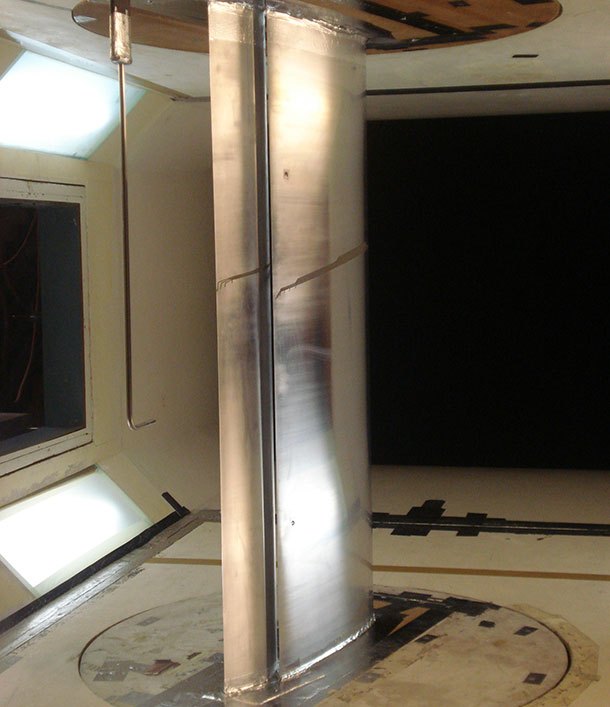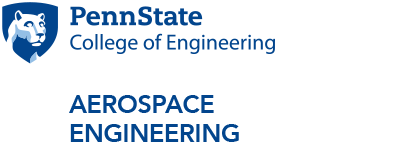
The slotted natural-laminar-flow airfoil is one of the innovative concepts at the heart of the NASA University Leadership Initiative which supports research for its Ultra-Efficient Commericial Vehicle's strategic thrust. Such an airfoil is shown mounted in the Low-Speed, Low-Turbulence Wind Tunnel at Penn State as part of a prior NASA-supported test, performed in conjunction with Airfoils, Incorporated.
Penn State Aerospace Engineering awarded $1.7M from NASA ULI
5/2/2017
UNIVERSITY PARK, Pa. — Penn State is a member of a multi-university research team led by researchers from the University of Tennessee (UT), Knoxville Tickle College of Engineering that was selected by NASA to explore transformative system-level aviation innovations as part of NASA Aeronautics’ University Leadership Initiative (ULI).
Under the ULI, the project team will aim to demonstrate a viable ultra-efficient aerodynamic wing-design concept that could be incorporated into commercial aircraft and contribute to a 70 percent reduction in aircraft fuel and energy consumption. This research will support NASA’s main aviation research goals under its Ultra-Efficient Commercial Vehicles strategic thrust.
Principal investigator for Penn State will be Sven Schmitz, associate professor of aerospace engineering. Additional Penn State researchers include Mark Maughmer, professor of aerospace engineering; Kenneth Brentner, professor of aerospace engineering; and Robert Campbell, research associate in Penn State’s Applied Research Laboratory and assistant professor of mechanical engineering.
“The opportunity to create a new wing with potential revolutionary drag reduction is a dream project for an aerospace engineering team consisting of aerodynamicists, an acoustician and a structural dynamicist,” said Schmitz.
The project team, which will be led by James Coder, Penn State alumnus (’08 AERSP, ’10 M.S. AERSP, ’14 Ph.D. AERSP) and assistant professor of aerospace engineering at UT, was one of five to receive a potential award from NASA. Total value of the five NASA ULI research awards will be approximately $50 million over five years, with the team receiving $9.9 million and Penn State receiving $1.7 million to support its efforts upon final negotiations.
“This innovative research project is an excellent example of how faculty members in the Department of Aerospace Engineering are contributing to future efficient and environmentally friendly aircraft,” said Philip Morris, interim head and Boeing/A.D. Welliver Professor of Aerospace Engineering. “Universities and industry in multidisciplinary teams working together on challenging problems are most likely to provide workable solutions that will deliver long-term benefits worldwide.”
In addition to Penn State and UT, the project team will be comprised of co-investigators from Texas A&M University, the University of Illinois at Urbana-Champaign, Old Dominion University and the University of Wyoming. The team will also include two industry partners—Boeing Research & Technology and Airfoils, Incorporated of Port Matilda, PA.
Overall research efforts of the multi-university team will focus on the design and system integration of a slotted natural-laminar-flow (SNLF) airfoil for 100-plus-passenger fixed-wing commercial aircraft—a drastic departure from existing wing designs that use a single-element airfoil in cruise and a multi-element airfoil that extends and retracts during takeoff and landing. This revolutionary concept would reduce wing drag significantly, while also enabling performance gains and weight savings.
“We can have a tremendous impact on the future of aviation by maturing a transformative concept for fuel savings of next-generation commercial aircraft,” said Schmitz. “In addition, the impact of this research goes beyond the technical and scientific aspects; it has the potential to significantly contribute to reducing carbon emissions from aircraft.”
Achieving the fuel/energy consumption goals with the SNLF concept will be performed in three phases—Technology Development, Technology Integration and Technology Demonstration—with associated, investigator-driven research tasks. Penn State will be responsible for four of the team’s 10 tasks:
-
Aeroelastic Behavior and Flutter Mitigation of Multi-element Wings (Campbell)
-
Aeroacoustic Predictions at Low-speed Flight Conditions (Brentner)
-
Application of Winglets to SNLF Transport Wing (Maughmer)
-
Theoretical Drag Decomposition of High-efficiency Aircraft (Schmitz)
Funding from NASA will enable Penn State to hire four graduate students who will conduct the majority of the research under the direct supervision of faculty investigators. Industry partners will also perform research while contributing to the students’ education through mentorship and internship opportunities.
“These awards further enhance the strong relationship we have with our university partners,” said Jaiwon Shin, NASA’s associate administrator for aeronautics. “We expect the awards will spur the nation’s leading universities to take a larger leadership role in advancing the revolutionary ideas needed to transform aviation and further advance U.S. global leadership in the aviation community.”






